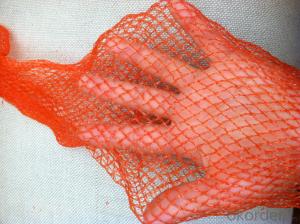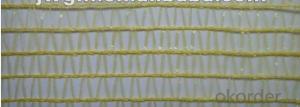Plastic Nets Knitting Mesh Bag Sleeve Bag Tubular Bag
- Loading Port:
- Shanghai
- Payment Terms:
- TT OR LC
- Min Order Qty:
- -
- Supply Capability:
- 200T m.t/month
OKorder Service Pledge
Quality Product, Order Online Tracking, Timely Delivery
OKorder Financial Service
Credit Rating, Credit Services, Credit Purchasing
You Might Also Like
tubular bag for fruit and vegetables
Product Description
We can produce a variety of mesh bag with high quality, including mesh bag (PP), raschel mesh bag (PE) and tubular mesh bag (PP).
Item: Leno mesh bag with label
Material: PP
Size: As customers' requirements
Color: Red, orange, yellow, green, purple, transparent etc.
They are widely used for packing vegetables, fruits, firewood and seafood. Such as onions, potato, garlic, orange, cabbage, carrot, apple, pear and so on.
| Material | PP (leno mesh bag, tubular mesh bag), PE (raschel mesh bag) |
| Width | As client' s requests |
| Length | Up to 85 cm |
| Weight | 30 GSM – 50 GSM |
| Color | red, orange, yellow, green, purple, transparent etc. |
| Sewing | L- sewing ( overlock sewing or fold sewing) |
| Delivery time | 15-30 days for a 40'FCL |
| Feature | With or without drawstring, with or without UV protection, with or without lable |
- Q: How do plastic nets help in water filtration?
- Plastic nets help in water filtration by trapping and removing larger debris and contaminants from water sources. The nets act as a physical barrier, preventing the entry of large particles such as leaves, twigs, or plastic waste into the filtration system. This helps to enhance the efficiency and effectiveness of the filtration process, ensuring cleaner and safer water output.
- Q: Are plastic nets resistant to pests and rodents?
- Yes, plastic nets are generally resistant to pests and rodents. The material used in plastic nets is not attractive to pests, and it is difficult for rodents to chew through or penetrate the netting. However, it is important to note that there is no material that is completely immune to all pests and rodents, so occasional incidents may still occur.
- Q: Can plastic nets be used for creating aquaponic systems?
- Yes, plastic nets can be used for creating aquaponic systems. They are commonly used as a support structure for the grow beds or floating rafts that hold the plants in the system. The netting allows the roots of the plants to grow through and be exposed to the nutrient-rich water, while also providing stability and preventing the media from falling into the water. Plastic nets are a cost-effective and versatile option for constructing aquaponic systems.
- Q: Are plastic nets customizable in terms of size and shape?
- Yes, plastic nets are customizable in terms of size and shape. They can be manufactured to various dimensions and configurations to suit specific requirements and applications.
- Q: How can plastic nets be disposed of properly?
- Plastic nets can be disposed of properly by recycling them through specialized recycling facilities or programs that accept plastic materials. Additionally, they can be taken to designated drop-off locations or recycling centers that handle plastic waste. It is important to ensure that the nets are clean and free from any other materials before recycling them to improve the recycling process.
- Q: Are plastic nets suitable for use in butterfly enclosures?
- No, plastic nets are not suitable for use in butterfly enclosures.
- Q: How do plastic nets provide support for sports fields?
- Plastic nets provide support for sports fields by preventing soil erosion and maintaining the integrity of the playing surface. They are used to secure the soil, prevent it from shifting, and control the movement of water. Additionally, plastic nets help in distributing the weight and pressure exerted by athletes, preventing damage to the playing surface and ensuring a safe and level field for sports activities.
- Q: Can plastic nets be used for creating bird netting?
- Yes, plastic nets can be used for creating bird netting.
- Q: Are plastic nets suitable for aquaculture?
- Yes, plastic nets are suitable for aquaculture. They are commonly used in fish farming to create cages or enclosures for fish, providing a secure and controlled environment. Plastic nets are durable, resistant to corrosion, and can be customized to suit the specific needs of different aquaculture operations. Additionally, they allow for proper water circulation and waste removal, while also protecting the fish from predators.
- Q: How do plastic nets compare to metal nets?
- Plastic nets are generally lighter, more affordable, and resistant to corrosion compared to metal nets. However, metal nets are stronger, more durable, and have higher load-bearing capacity. The choice between plastic and metal nets depends on the specific application and desired characteristics.
Send your message to us
Plastic Nets Knitting Mesh Bag Sleeve Bag Tubular Bag
- Loading Port:
- Shanghai
- Payment Terms:
- TT OR LC
- Min Order Qty:
- -
- Supply Capability:
- 200T m.t/month
OKorder Service Pledge
Quality Product, Order Online Tracking, Timely Delivery
OKorder Financial Service
Credit Rating, Credit Services, Credit Purchasing
Similar products
Hot products
Hot Searches
Related keywords


























